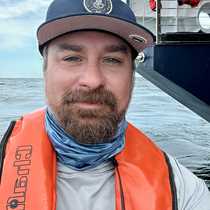Today was a day of exploration for all onboard the National Geographic Endeavour II, at Isabela Island. Due to several species eradication projects on both North Seymour and Rabida Islands, the National Geographic Endeavour II deviated from its traditional route and visited two visitor sites that were new to our expedition itinerary: Elizabeth Bay and Punta Moreno. In the morning, guests went on a Zodiac cruise in Elizabeth Bay, where they were greeted by a large group of active Galapagos penguins. We also observed the yellow morphotype of the Pacific green sea turtle, a rare sighting in Galapagos. We also observed great blue herons, Galapagos sea lions, and brown pelicans. There is a great deal of biodiversity that the mangrove ecosystem supports.
In the afternoon, guests explored the marine realm of Punta Moreno. Even with low visibility, we observed an enormous amount of Pacific green sea turtles at the snorkel site. There were up to nine green sea turtles feeding in a single group at a given time. The Cromwell subsurface current that collides with the western facing side of the Galapagos archipelago make for cold, nutrient-rich waters and prime habitat for the green sea turtles’ favorite food: ulva. For this reason, we see a disproportionate abundance of green sea turtles in this region of the archipelago. These cold, nutrient rich waters also make for an ideal habitat for the Galapagos penguin. Two penguins came very close to us while snorkeling, providing us with an up-close observation of their feeding behavior.
We ended the day with a hike along an extensive lava field found at Punta Moreno. Guests learned about pioneer plants, such as lava cactus, that colonize these harsh environments before any other vegetation. We also discussed geology and the formation of the islands, given that the Galapagos hotspot is located in the very region in which we were hiking.










